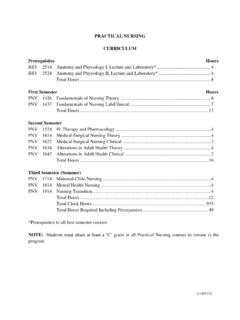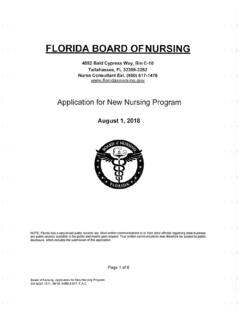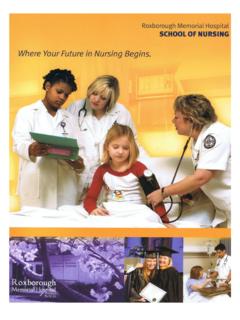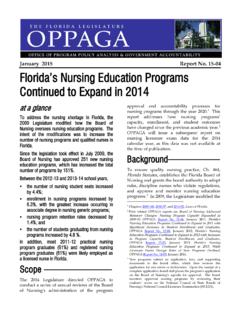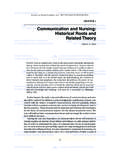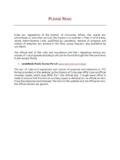Transcription of FUNDAMENTALS OF NURSING I & II BASIC & …
1 FUNDAMENTALS OF NURSING I & II BASIC & ADVANCED SKILLS COURSE DESCRIPTION TEXTS: Burton, M. A., & Ludwig, L. J. M. (2015). FUNDAMENTALS of NURSING Care: Concepts, Connections & Skills (2nd ed.). Philadelphia: Davis Company. Study Guide and Videos to Accompany: Burton, M. A., & Ludwig, L. J. M. (2015). FUNDAMENTALS of NURSING Care: Concepts, Connections & Skills (2nd ed.). Philadelphia: Davis Company. DESCRIPTION: During this course, the student learns the technical procedures used in direct patient care. The course is designed to progress from simple to complex and to enable the student to understand the rationale for various procedures and treatments. The NURSING process in introduced as a method of problem solving and foundation for delivery of client care.
2 The student will perform NURSING skills and function within the scope of practice from a practical nurse in the long term care setting. In addition, the student will learn BASIC information about the family unit and family dynamics, problems that may occur in the family structure, and BASIC gerontologic concepts related to the care of the aging client. TERMINAL OBJECTIVES: Upon completion of this unit, the student will demonstrate knowledge on written examinations, with a minimum score of 80%. Students will demonstrate the BASIC NURSING skills with 100% accuracy. GRADE ASSIGNMENT: Theory grade will be determined as follows: Tests & Assignments 85% Final Exam 15% Clinical grade will be satisfactory or unsatisfactory based upon evaluation of NURSING actions and criteria outlined in clinical syllabus.
3 HOURS: Theory Hours 107 hours that include: AV Aids 13 hours Testing 11 hours Integrated Course Hours Growth/Devel 13 hours Geriatrics 12 hours Lab Hours 41 hours Total Theory/Lab Hours 148 Hours Total Clinical Hours 82 Hours Total Course Hours 230 Hours Written: 09/90 Reviewed: 09/92, 09/94, 08/03; 03/06; 09/13 Revised: 09/95, 09/96, 09/97, 10/98, 10/99, 12/00, 08/01, 12/02, 12/03; 12/04; o6/07; 06/09; 08/11; 01/15; 10/15 2 FUNDAMENTALS / BASIC NURSING SKILLS: LESSON OVERVIEW Lesson Title Hours 1 Introduction to the NURSING Process 1 2 Documentation 2 3 Patient Teaching 2 4 Safety 3 5 Body Alignment, Balance & Movement/Using Body Mechanics 4 6 Introduction to Infectious Process and Standard Precautions 5 7 Personal Care 8 8 Hospital Beds 4 9 Range of Motion Exercises 2 10 Moving and Positioning 5 11 Transferring a Patient out of Bed 3 12 Patient Ambulation, Wheelchairs.
4 And Stretchers 3 13 Urinary Elimination 14 Bowel Elimination 4 15 Assisting with Nutrition 16 Fluid Intake and Output 3 17 Temperatures 18 Pulse and Respiration 4 19 Blood Pressure 5 Total Theory and Lab Hours Written: 10/15 3 FUNDAMENTALS /ADVANCED NURSING SKILLS: LESSON OVERVIEW Lesson Title Hours 1 Nasogastric Tubes 3 2 Assisting with Examinations and Procedures 3 3 BASIC Assessment 4 Specimens 3 5 Care of the Patient Using Oxygen 1 6 Skin Care 1 7 Applying Heat and Cold 2 8 Irrigations 4 9 Applying Bandages and Binders 4 10 Sterile Technique 6 11 Sterile Dressings 3 12 Urinary Catheterization 2 13 Tracheostomy Care 2 14 Admission, Discharge, and Patient Transfer 2 15 IV Therapy and Venipuncture 16 NURSING Process Total Theory and Lab Hours Written: 10/15 4 Unit: BASIC NURSING Skills Lesson.
5 1 Title: Introduction to the NURSING Process Time: Theory 1 hour Implementation: Burton, Ch. 4; Lecture/Class Discussion; PowerPoint Evaluation: Post Test, Application in Patient Care Integrated: N/A OBJECTIVES Upon completion of this unit, the student will be able to: 1. Define key terms associated with NURSING process and decision making. 2. Discuss ways critical thinking is used in NURSING . 3. Enumerate the steps of the NURSING process. 4. Contrast subjective and objective data. 5. List techniques used to gather data during a physical assessment. 6. Describe how Maslow s hierarchy of human needs is used to prioritize NURSING diagnoses. 7. Describe the four blended skills essential to NURSING practice.
6 Written: 09/90 Reviewed: 06/92, 06/97, 08/98, 08/00; 03/06; 06/09; 09/13; 10/15 Revised: 06/94, 08/96, 12/02; 12/04; 06/07; 08/11 PLAN OF LESSON I. Definition II. Critical Thinking in NURSING III. Five Steps of the NURSING Process A. Assessment B. Diagnosis C. Planning D. Implementation E. Evaluation and Documentation IV. Role of LPN in NURSING Process V. Data A. Subjective B. Objective VI. Gathering Data A. Who B. How VII. Maslow s Hierarchy 5 Unit: BASIC NURSING Skills Implementation: Burton, Ch. 5; Lecture/Class Discussion; Handouts Lesson: 2 Evaluation: Post Test, Application in Patient Care Title: Documentation Integrated: N/A Time: Theory 2 Hours OBJECTIVES Upon completion of this unit, the student will be able to: 1.
7 Define key terms associated with documentation. 2. Explain four purposes of written documentation. 3. Discuss confidentiality of patient records. 4. Summarize 12 guidelines for documentation. 5. Compare source-oriented and problem-oriented documentation systems. 6. List the common sections of a source-oriented documentation system. 7. Compare PIE charting and SOAPIER charting formats. 8. Contrast charting by exception and focus charting. 9. Explain how narrative charting is different from all other formats. 10. Enumerate the advantages and disadvantages of computerized charting. Written: 09/90 Reviewed: 06/92, 06/97, 08/98, 08/00; 03/06; 06/09; 09/13 Revised: 06/94, 08/96, 12/02; 12/04; 06/07; 08/11; 10/15 PLAN OF LESSON I.
8 Terminology II. Purposes of Documentation III. Confidentiality A. HIPAA IV. Guidelines for Documentation V. Methods of Documentation A. Problem-Oriented B. Source-Oriented C. PIE D. SOAPIER E. Charting by Exception F. Focus Charting G. Narrative Charting VI. Computerized Charting A. Advantages B. Disadvantages 6 Unit: BASIC NURSING Skills Lesson: 3 Title: Patient Teaching Time: Theory 2 Hours Implementation: Burton, Ch. 12; Lecture/Class Discussion; PowerPoint Evaluation: Post Test, Application in Patient Care Integrated: N/A OBJECTIVES Upon completion of this unit, the student will be able to: 1. Identify three primary learning styles. 2. Explain ways to address learning styles during patient teaching.
9 3. Describe factors that affect learning. 4. Discuss information to consider when arranging for an interpreter. 5. Discuss the importance of reinforcement of patient teaching. 6. Identify two primary purposes of patient teaching. 7. Define the concept of teachable moments. 8. Describe how to develop a teaching plan using the NURSING process. 9. Discuss ways to implement a teaching plan. 10. Describe three ways to evaluate patient teaching. 11. Explain how to teach patients about Internet resources. Written: 08/11 Reviewed: 09/13; 10/15 PLAN OF LESSON I. Learning Styles A. Auditory B. Visual C. Kinesthetic II. Learning Styles with Patient Teaching III. Barriers IV. Interpreters V.
10 Reinforcement VI. Purposes of Patient Teaching VII. Teachable Moments VIII. Teaching Plan A. Development B. Implementation C. Evaluation IX. Internet Resources 7 Unit: BASIC NURSING Skills Lesson: 4 Title: Safety Time: Theory 3 Hours Implementation:Burton, Ch. 13; PowerPoint; Lecture/Class Discussion Evaluation: Post Test, Application in Patient Care Integrated: N/A OBJECTIVES Upon completion of this unit, the student will be able to: 1. Explain areas addressed by National Patient Safety Goals. 2. Describe six factors that contribute to an unsafe patient environment. 3. Discuss the use of fall-assessment scales and restraint alternatives in preventing falls.

